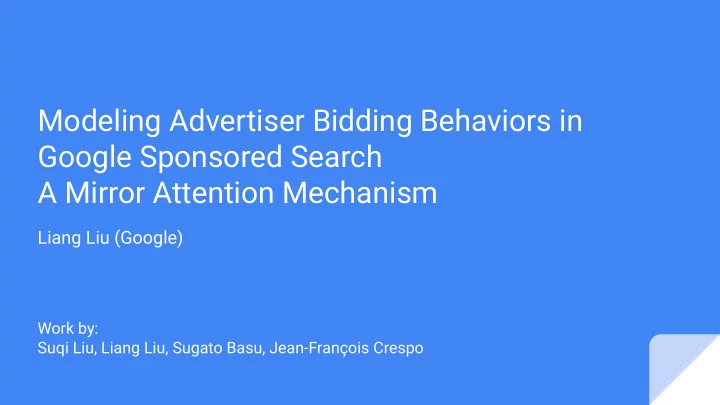

Modeling Advertiser Bidding Behaviors in Google Sponsored Search A Mirror Attention Mechanism Liang Liu (Google) Work by: Suqi Liu, Liang Liu, Sugato Basu, Jean-François Crespo
Background Advertisers respond to feature launches in ads system ● A feature launch can result in changes in certain metrics ● Advertisers respond in various ways to the metrics that they observed ● Long term effect of a launch needs to take these response into account
How do Launches Affect System Metrics Auction Render and show Metrics Bid
How do Advertisers Respond metric initial long-term impact impact production ±0% responsive unresponsive long-term -X% response time Some time later start
Goal of Modeling Advertisers ● Predict metrics considering long-term bids Metrics advertiser response to launches in ads system ● Aims to estimate advertiser response time before / during / after a launch How do we model advertiser response? ● Advertisers can respond to a change in the ad system in different ways ○ Adjust bid, budget, campaign structure, etc. ● We currently model bid adjustments made by advertisers ● Have to model (a) individual response, (b) response interaction via auction
Complexity of Problem ● Advertisers reactions are affected by various reasons ○ E.g., targeting strategy changes ● Advertiser responses are not IID ○ Interaction via the auction in each impression ● Advertiser's reaction can be long-term ○ Change budget allocation at end of quarter ● Super-tricky to get advertiser response ground truth ○ Data sparsity, noise
Advertiser Response Offline Experiment ● Reinforcement-learning like framework ○ Decouple the system(auction) and advertisers. ○ Iteratively run two components ● Treat advertisers as black-box ○ Directly model advertiser response from historical data. ○ Only model short-term response.
Advertiser Response Models ● Descriptive: Invariant models ○ Preserve invariants: Spend / Conversions / Impression/ CPC ■ ○ Other strategies (e.g., constrained utility maximization) ● Predictive: ○ Prediction model for direct regression
Metrics Features and Transformation Raw features: Derived features ● Impressions ● CTR (clicks/impressions) ● Clicks ● CVR (conversions/clicks) ● Conversions ● CBR (cost/budget) ● Budget ● CPC (cost/clicks) ● Cost ● Slot https://support.google.com/google-ads/, snapshot on 2019.07.20
Data Form: Multivariate Time Series Driver Sequence Impressions Clicks Cost Ads Positions …... Response Sequence Bids
Model Trials: Regression Model Bids Metrics window size w
Model Trials: Single Sequence Model(RNN) Bids RNN Metrics
Model Trials: Double Sequence Model (Dual RNN) Bids RNN RNN Metrics
Attention Mechanism ● Ideally sequence models should be able to capture long range dependencies, but is difficult in reality. ● When making prediction, focus (i.e., attend) on relevant part of input ● In our context, to focus on relevant parts of historical sequence
Model Trials: Casual Attention Model Bids Metrics
Model Trials: Mirror Attention Model Bids Metrics
Testbed: Air Quality Data ● Air quality data from UCI ML repository [source] ● Multivariate time-series ● The dataset resembles the advertiser response ○ The concentration of pollutant has its own evolution [response metrics] ○ Concentration is influenced by weather conditions like temperature, pressure, wind speed, cumulative hours of rain, etc [driver metrics]
Results on Air Quality Test Data ● DSEQ and MATT achieves better results when we increase the difficulty of the prediction task with larger predicting gap ● MATT performs consistently among the best models
Results on Advertiser Bid History Data ● Length of attention window plays an important role ● The dimensions of hidden states in the driver sequence and response sequence significantly contribute to performance ● Parameter tuning discussed in paper
Conclusion ● Introduced a new data-driven approach to advertiser bid prediction ● A novel mirror attention mechanism tailored to the sequential prediction task was proposed ● The first step in our attempts towards understanding advertiser behaviors via sequence modeling ● Following up work to introduce more auction rules and policy into the models to strengthen from a pure multivariate time series model
Beyond Bid Response: Other Applications The model we developed can potentially have more impacts when applied to the following tasks. ● Resource usage in systems ● User behavior modeling ● Weather prediction ● Financial market forecasting
Thanks!
Recommend
More recommend